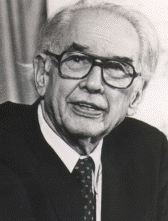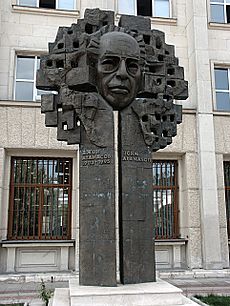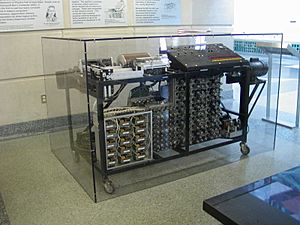John Vincent Atanasoff facts for kids
Quick facts for kids
John Vincent Atanasoff
OCM
|
|
|---|---|

Atanasoff in the 1990s
|
|
| Born | October 4, 1903 Hamilton, New York, U.S.
|
| Died | June 15, 1995 (aged 91) Frederick, Maryland, U.S.
|
| Known for | Atanasoff–Berry Computer |
| Awards | Order of Saints Cyril and Methodius, First Class |
| Scientific career | |
| Fields | Physics |
| Doctoral advisor | J. H. V. Vleck |
John Vincent Atanasoff (October 4, 1903 – June 15, 1995) was an American physicist and inventor. He is famous for creating the first electronic digital computer. His parents were from Bulgaria and Ireland.
Atanasoff built his first electronic digital computer in the 1930s. He worked at Iowa State College (now Iowa State University). For many years, there was a debate about who invented the computer. But in 1973, a court case decided that Atanasoff was the true inventor. His special computer is known as the Atanasoff–Berry Computer.
Contents
Early Life and School Days
John Atanasoff was born on October 4, 1903, in Hamilton (village), New York. His father was an electrical engineer from Bulgaria. His mother was a math teacher with French and Irish family roots. John's parents helped him become curious about science and learn to think critically.
He grew up in Brewster, Florida. When he was nine, he learned to use a slide rule, a tool for math problems. Soon after, he studied logarithms, which are advanced math concepts. He finished high school in just two years. In 1925, he earned a degree in electrical engineering from the University of Florida.
Atanasoff continued his studies at Iowa State College. In 1926, he earned a master's degree in mathematics. He finished his education in 1930 with a PhD (a very high degree) in physics from the University of Wisconsin–Madison. After that, he became an assistant professor at Iowa State College. He taught both math and physics.
How the Computer Was Developed
While working on his PhD, Atanasoff used a mechanical calculator called the Monroe. It was slow and tiring to use. This made him want to find faster ways to do calculations. At Iowa State, he tried using Monroe calculators and IBM machines together. But he realized that mechanical parts had limits. He started thinking about electronic solutions instead.
In September 1939, Atanasoff received $650 to help with his project. With the help of his student, Clifford Berry, they built a test version of the Atanasoff–Berry Computer (ABC). It was ready by November of that year. Atanasoff said he got the main ideas for the ABC during a drive in the winter of 1938.
The ABC used key ideas like binary math (using only 0s and 1s). It also used Boolean logic to solve up to 29 linear equations at once. The ABC did not have a central processing unit (CPU) like modern computers. Instead, it used vacuum tubes for its calculations. It also had a special memory system using capacitors. This system worked in a similar way to today's DRAM memory.
The Computer Patent Fight
Atanasoff first met John Mauchly in December 1940. Mauchly was showing off his own analog calculator. Atanasoff told Mauchly about his new digital computer and invited him to see it.
In June 1941, Mauchly visited Atanasoff at his home in Ames, Iowa for four days. They talked about the ABC computer and looked at Atanasoff's design notes. Later in 1941, Atanasoff left Iowa State for a job during World War II. He became the Chief of the Acoustic Division in Washington, D.C. Iowa State College never filed a patent for the ABC.
Mauchly visited Atanasoff several times in Washington during 1943. They discussed computer ideas. But Mauchly did not tell Atanasoff that he was working on his own computer project until 1944.
After the war, a big legal battle began. From 1954 to 1973, Atanasoff was a witness in lawsuits. These cases tried to prove that patents for electronic computers, owned by Sperry Rand, were not valid. These patents had been given to Mauchly and J. Presper Eckert.
In 1973, a federal judge, Earl R. Larson, made an important decision. He ruled that "Eckert and Mauchly did not themselves first invent the automatic electronic digital computer." Instead, he found that they got their ideas from Dr. John Vincent Atanasoff. This ruling officially recognized Atanasoff as the inventor of the electronic digital computer.
Life After the War
After World War II, Atanasoff continued to work for the government. He developed special tools like seismographs and microbarographs. These tools could detect explosions from far away. In 1952, he started his own company, Ordnance Engineering Corporation. He sold it in 1956 and became a president at Aerojet General Corporation. He retired from Aerojet in 1961.
In 1960, Atanasoff and his wife, Alice, moved to their farm in New Market, Maryland. In 1961, he started another company called Cybernetics Incorporated. He ran this company for 20 years. During this time, he also created a phonetic alphabet for computers. After the court case, Honeywell v. Sperry Rand, Atanasoff received many honors. Iowa State University, his old college, welcomed him warmly.
John Atanasoff passed away on June 15, 1995, at the age of 91. He died from a stroke at his home after being sick for a long time. He is buried in Pine Grove Cemetery in Mount Airy, Maryland.
His Legacy
Atanasoff visited Bulgaria twice, in 1975 and 1985. He went to Boyadzhik village, where his grandfather was born. The local people and his relatives welcomed him warmly. He was made an honorable citizen of the town of Yambol. He also received many awards from the Bulgarian Academy of Sciences.
Today, the John Atanasov prize is given out every year in Bulgaria. An asteroid found by the Bulgarian observatory, 3546 Atanasoff, was named after him.
Awards and Honors

Atanasoff received his first major award in 1970. It was the Order of Saints Cyril and Methodius, First Class. This is Bulgaria's highest science honor. He received it before the 1973 court ruling.
In 1990, President George H. W. Bush gave Atanasoff the National Medal of Technology. This is the highest U.S. award for achievements in technology.
Other awards Atanasoff received include:
- U.S. Navy Distinguished Service Award (1945)
- Doctor of Science (Honoris Causa) University of Florida (1974)
- Iowa Inventors Hall of Fame (1978)
- Computer Pioneer Medal from the Institute of Electrical and Electronics Engineers (IEEE) (1981)
- Iowa Governor's Science Medal (1985)
- Foreign Member of the Bulgarian Academy of Sciences (1985)
- Honorary citizen of the city of Yambol, Bulgaria (1985)
- Doctor of Science (Honoris Causa) University of Wisconsin–Madison (1987)
Things Named After Atanasoff
Many places and awards are named after John Atanasoff:
- Atanasoff Nunatak (a mountain peak) in Antarctica.
- The asteroid (3546) Atanasoff.
- Atanasoff Hall, a computer science building at Iowa State University.
- The John Atanasoff Award, given annually by the President of Bulgaria for achievements in computer and information technologies.
- The John Atanasoff Technical College in Plovdiv, Bulgaria.
- The John Atanasoff Bulgarian national tournament in informatics, held in Shumen.
- Several high schools and cultural centers in Bulgaria.
- The John Atanasoff Bulgarian Language School in Chicago, Illinois.
- Streets in Yambol and Sofia, Bulgaria.
See also
 In Spanish: John Atanasoff para niños
In Spanish: John Atanasoff para niños


